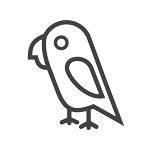
Cairn Terrier: The Ultimate Guide to This Feisty Little Legend
Ever looked at a little scruffy dog and thought, “Wow, that one looks like it’s got opinions”? Chances are, you’ve just crossed paths with a Cairn Terrier.
Compact, clever, and completely unbothered by their size, Cairn Terriers are one of the oldest terrier breeds still kicking about today. Originating in the Scottish Highlands, they were bred to chase foxes, badgers, and other critters hiding in rocky outcrops—known as cairns, hence the name. But don’t let their rustic working-dog roots fool you. These dogs have comfortably traded fox holes for sofas, and they’re just as happy snuggling as they are scuffling.
Thanks to their wiry coats, keen eyes, and a spark of defiance, Cairns are often mistaken for “just a scruffy mutt” by those not in the know. But if you’ve lived with one, you’ll know: they’re so much more. Loyal to a fault, natural comedians, and always up for an adventure, Cairn Terriers pack a lot of dog into a tiny body.
In this guide, we’re diving deep into the world of Cairn Terrier terrier breeds—from what they eat, to how they behave, and whether they’re a good match for your household. We'll also cover Cairn Terrier puppies, mixes, grooming tips, health conditions, and even the average lifespan of a Cairn Terrier so you can be fully clued in before committing to this bold little companion.
The Origins of the Cairn Terrier
A Breed Born from the Scottish Highlands
The Cairn Terrier is no recent trendsetter—it’s a breed with grit, history, and centuries of hard work behind those fluffy ears. Hailing from the windswept Scottish Highlands, Cairns were originally bred as working dogs, tasked with flushing out rats, foxes, and other pests from rock piles—aka cairns. Their small size, nimble bodies, and fierce determination made them perfect for scrambling into tight spaces where bigger dogs simply couldn’t go.
Before they were known by name, Cairn Terriers were grouped with other small terriers from the region. In fact, they weren’t officially recognised as a distinct breed until 1912 by the Kennel Club in the UK—one of the last terriers to earn this formal title. Before that, many of their relatives were registered as Skye Terriers, despite differences in build and coat type.
From Fox Hunter to Family Favourite
While the Cairn Terrier’s original job was all about pest control, it didn’t take long for their cheeky charm and confident personality to win over families, too. Their claim to fame? A starring role in The Wizard of Oz (1939), where a Cairn named Terry played the beloved Toto. That role didn’t just steal Dorothy’s heart—it captured the world’s.
Since then, the breed’s popularity has grown globally, especially in countries like Australia, where their tough little frames and adventurous natures make them brilliant companions for both city dwellers and country folk alike.
Cairns are one of the oldest terrier breeds still around today, making them not only hardy but deeply rooted in tradition. They're proof that good things truly do come in small (and slightly scruffy) packages.
Personality & Temperament

Are Cairn Terriers Good Pets?
Short answer? Yes—but only if you’re up for a bit of personality-packed chaos. Cairn Terriers make fantastic pets for the right home. They’re loving, loyal, and lively. But don’t mistake their small stature for a lapdog vibe. These dogs were bred to work—and that natural instinct still pulses through their paws.
They thrive in active households where they can play, explore, and supervise (read: get into everyone’s business). If you’re after a couch potato, look elsewhere. If you want a dog who’s curious, playful, and always up for an adventure? The Cairn might just be your soulmate.
Independence vs Affection: A Terrier Tug-of-War
Cairns walk that fine line between fiercely independent and downright clingy. They want to be part of the action, but on their own terms. You’ll often find them trailing you from room to room, yet shooting you that “I don’t need you” look at the same time.
They’re emotionally intelligent and naturally confident, but that can tip into stubbornness if boundaries aren’t set early on. Training is absolutely key—and patience helps, too.
Good with Kids, But What About Cats?
Cairn Terriers are usually excellent with older kids who understand how to respect a dog’s space. They love playtime and will happily chase a ball (or a child holding snacks). However, their natural prey drive means they’re not always the best match for small animals like rabbits or guinea pigs.
As for cats? It depends. If raised with them, many Cairns will get along just fine. But don’t be surprised if your Cairn chases the neighbour’s moggy out of the backyard—again. It’s nothing personal. It’s just their nature.
Appearance, Looks & Natural Markings
Size, Build & That Signature Scruff
If Cairns were people, they’d be the rough-and-ready adventurers with muddy boots and wild hair—and they’d wear it with pride.
The Cairn Terrier is a small but sturdy breed, usually standing around 23–33 cm tall at the shoulder and weighing 6–8 kg. They’ve got a compact, well-balanced frame—strong enough to dig for hours but small enough to fit on your lap (whether you invited them or not).
What sets them apart visually is their double coat. The outer layer is wiry and weather-resistant—perfect for their rugged Scottish roots—while the undercoat is soft and insulating. It’s this combo that gives Cairns their signature tousled, unbothered look.
Classic Cairn Colours
Cairn Terriers come in a range of earthy tones that help them blend right in with the stone piles they were once bred to patrol. You’ll commonly see:
-
Cream
-
Wheaten (light beige)
-
Red
-
Brindle (a mix of dark and light hairs)
-
Grey
-
Black
One fun fact: their coat colour can change over time. So that wheaten puppy you brought home might end up with darker tips as they age. It’s all part of their natural charm.
Facial Features That Speak Volumes
Cairns have wide-set, dark eyes that sparkle with mischief—and they often look like they’re plotting something (because they are). Their ears are small, pointy, and sit high on the head, always alert and twitching at the sound of… well, anything.
Despite their shaggy coats, their expressions are remarkably easy to read. You’ll know when your Cairn’s curious, cheeky, or up to no good—and those bushy eyebrows don’t lie.
Training & Exercise Needs

Mental Stimulation Is Non-Negotiable
A bored Cairn Terrier is a destructive Cairn Terrier. It’s not personal—they’re just hardwired to be busy. Remember, these dogs were bred to problem-solve underground, unearthing critters and navigating rocky terrain. So if you think a casual stroll around the block will cut it? Think again.
Cairns need daily mental stimulation just as much as physical exercise. Puzzle feeders, interactive toys, scent work games, and regular training sessions can all help keep that active little brain from getting bored. And bored Cairns will dig up your garden or redecorate your cushions.
Socialising Your Cairn Early
Socialisation is absolutely essential, especially during the first few months with Cairn Terrier puppies. While they’re naturally bold and curious, they can become reactive or nippy if not properly introduced to different people, pets, and environments early on.
Start slow, keep things positive, and reward often. With consistent exposure to the world, Cairns grow into confident, sociable adults.
Off-Leash? Only If You Dare
Here’s the thing about Cairn Terriers and recall: they can learn it, but their prey drive often overrides obedience. That fluttering leaf? It's now an emergency mission. The squirrel 30 metres away? A personal challenge.
Unless you’ve got a fully fenced yard or have put in serious recall training, it’s best to keep Cairns on a lead or long line. They’re not trying to be naughty—they’re just following their nature.
Daily Movement They’ll Actually Enjoy
Cairns don’t need marathon runs, but they do need a couple of solid walks each day (at least 30–60 minutes total), plus playtime and the chance to sniff and explore. Off-lead dog parks can work for well-socialised Cairns, but be aware—they can get snarky if another dog invades their space.
Indoor play can also work well, especially with durable dog toys or an enriching pet playpen setup to keep them safely contained while still having fun.
Grooming & Care
The Wiry Coat: Low-Shedding but High-Maintenance
Cairn Terriers may not shed much, but their double coat does need regular attention to keep it looking (and feeling) great. Their outer coat is coarse and weather-resistant, while the undercoat is soft and dense. Left unattended, that combo can easily mat or trap debris—especially after a good roll in the garden.
Brushing your Cairn 2–3 times a week is ideal. Use a slicker brush or a pin brush to detangle and remove dirt. During seasonal coat changes, you might need to increase that to daily grooming.
To Strip or Not to Strip?
Here’s where it gets specific. Cairns benefit from a grooming method called hand-stripping—removing dead hairs by hand or with a stripping knife to maintain the texture of the coat. If you take them to a groomer, ask for someone experienced with terrier coats.
Clipping is fine for pet homes, but it’ll soften the coat over time and can make it more prone to tangles or matting. That’s not a disaster—it’s just a style choice.
Nail Clipping, Ear Cleaning & More
It’s not all about the fur. Cairn Terriers also need regular nail trims (every 3–4 weeks), weekly ear checks (especially if they love digging), and an occasional bath when they start to smell more like compost than a canine.
Pro tip: Use a natural, non-irritating dog shampoo to avoid stripping the coat’s oils. Cairns tend to have sensitive skin, so less is more when it comes to bathing.
Helpful Tools for Home Grooming
At-home grooming doesn’t have to be a battle. A few handy items from PaWz can make the process smoother:
-
A PaWz pet grooming kit with quiet clippers and safety guards for trimming in between pro sessions
-
A calming dog bed to help your Cairn relax before and after grooming
-
Non-slip pet mats to stop your dog sliding during bath time
Make grooming part of your bonding time, not a dreaded event. With the right tools and routine, even a squirmy Cairn can learn to tolerate—dare we say, enjoy—a brush and tidy-up.
Feeding & Nutrition

What’s the Best Diet for a Cairn Terrier?
Cairn Terriers may be small, but they burn through energy like nobody’s business. A high-quality, well-balanced diet is essential to support their active nature and keep their coat, skin, and joints in tip-top shape.
Look for premium dog food with:
-
Real meat (chicken, lamb, fish or beef) as the main ingredient
-
Healthy fats like omega-3s for skin and coat health
-
Easily digestible carbs like sweet potato or rice
-
No fillers like corn, wheat or artificial preservatives
For Cairn Terrier puppies, a diet tailored to small breed growth is ideal—packed with nutrients to support joint development and a healthy immune system. Stick to recommended portion sizes and avoid overfeeding. These pups are sturdy, but they can put on weight fast if left to free-feed.
How Often Should You Feed Them?
Here’s a handy breakdown:
-
Cairn Terrier puppies (under 6 months): 3–4 small meals a day
-
Adults (6 months to senior): 2 meals a day
Free feeding isn’t recommended—it can lead to weight gain and disrupt toilet training routines. Scheduled meals also help with training and digestion.
Foods to Avoid for Cairn Terriers
Like many terrier breeds, Cairns can be prone to food allergies or sensitivities. Common triggers include:
-
Beef or chicken by-products
-
Dairy
-
Artificial colourings
-
Grains like wheat or soy
And of course, steer well clear of toxic human foods like chocolate, grapes, onions, garlic, and xylitol (found in some sugar-free products). Even a small amount can be dangerous.
Tips to Keep Feeding Easy
-
Use a slow-feeder dog bowl if your Cairn scoffs their food too quickly
-
Stick to routine mealtimes to avoid begging behaviours
-
Keep fresh water available at all times—especially after exercise or play
For an added boost, try using a puzzle feeder to make mealtimes mentally enriching. It taps into their natural instinct to “work” for food, which they love.
Common Health Conditions in Cairn Terriers

A Hardy Breed, But Not Invincible
Cairn Terriers are one of the tougher terrier breeds, built for the rugged Scottish Highlands with a strong constitution and a go-all-day attitude. But like all pedigree breeds, they do have a few hereditary health conditions to be aware of.
Buying from a reputable breeder who conducts genetic screening is essential if you’re bringing home a Cairn Terrier puppy. Regular vet checkups and a solid care routine will also go a long way in keeping them fighting fit.
Top Health Concerns in Cairn Terriers
Here are the most commonly seen issues in the breed:
• Craniomandibular Osteopathy (CMO)
A condition seen in puppies, where the bones of the jaw and skull thicken painfully. It usually shows up between 4–8 months and may resolve as they mature. It’s genetic, so breeders should screen for it.
• Allergies & Skin Issues
Cairns often suffer from itchy skin, known as atopic dermatitis. Triggers can include pollen, grass, dust mites or certain foods. You may notice excessive scratching, licking paws, or ear infections.
• Legg-Calvé-Perthes Disease
A condition where the hip joint deteriorates, typically seen in younger dogs. Symptoms include limping, stiffness, or reluctance to play. Surgery may be required.
• Luxating Patella
This is when the kneecap slips out of place—common in small breeds. It can vary in severity and may cause an odd skipping gait or reluctance to jump.
• Eye Problems
Cairns can be prone to progressive retinal atrophy (PRA) and cataracts. Both can impact vision and may eventually lead to blindness.
Average Lifespan of a Cairn Terrier
On the bright side, Cairns are long-lived dogs. The average lifespan of a Cairn Terrier is between 13 to 15 years, with many living well into their late teens with good care.
To support their longevity, make sure you’re:
-
Keeping up with yearly vet visits
-
Feeding a balanced, high-quality diet
-
Maintaining a healthy weight
-
Staying on top of flea, tick, and worming treatments
-
Using supportive accessories like an orthopaedic dog bed to protect joints as they age
Living With a Cairn Terrier
Cairn Terrier Price in Australia: What to Expect
Bringing home a Cairn Terrier puppy isn’t just an emotional investment—it’s a financial one too. In Australia, the price of a Cairn Terrier from a reputable breeder typically ranges between $1,200 to $3,000, depending on:
-
Breeder reputation and location
-
Pedigree lines and health testing
-
Whether the puppy is pet or show quality
Avoid buying from backyard breeders or online listings with unusually low prices—it often means corners have been cut, especially around health checks.
Ongoing Costs: Budgeting for the Long Haul
Beyond the initial Cairn Terrier price, here’s what else to factor in:
-
Vet care (annual check-ups, vaccinations, parasite prevention)
-
Pet insurance (optional but recommended for this active breed)
-
Grooming (either DIY tools or professional sessions)
-
Food and treats
-
Toys, leads, beds, and grooming tools
-
Accessories like a dog playpen or travel crate
A realistic yearly cost for a Cairn can sit anywhere from $1,000 to $2,000, depending on your lifestyle and care choices.
Cairn Terrier Mixes: What to Expect
Cairn Terrier mixes—like the Cairnoodle (Cairn Terrier x Poodle) or Cairnchi (Cairn x Chihuahua)—are growing in popularity. These hybrids often combine the Cairn’s boldness with traits like non-shedding coats or calmer temperaments, depending on the cross.
However, they can still inherit the Cairn’s stubborn streak and high energy levels, so don’t expect a chilled-out lapdog just because there’s a Poodle involved.
Creating a Terrier-Proof Home
Living with a Cairn means accepting they’re naturally curious, occasionally mischievous, and always on high alert. A few smart home choices will make life easier:
-
Use a dog playpen or baby gate to limit access to off-limits areas
-
Provide a raised dog bed or calming dog bed where they can chill after adventures
-
Keep bins sealed and food out of reach (they will find it)
-
Offer a rotation of toys to avoid boredom destruction
If you’ve got a backyard, make sure fences are secure and low gaps are blocked. Cairns are diggers by nature, and some can squeeze through surprisingly tight spaces.
Looks, Colours & Markings
A Naturally Weather-Resistant Wardrobe
The Cairn Terrier's coat isn’t just adorable—it’s practical, too. This breed was built for the outdoors, and it shows in their shaggy double coat that protects them from wind, rain, and chill. That coarse, tousled outer layer and soft undercoat make them naturally dirt-resistant. They’ll happily plough through bushes, mud, and puddles—and still look charming doing it.
One of the perks? They're low shedders, which is a nice bonus for allergy-sensitive homes. But they do require regular grooming to stop that natural texture from tangling or matting.
Coat Colours: From Cream to Brindle
Cairns come in a palette of earthy tones that blend in beautifully with the landscape. The most common colours include:
-
Wheaten – a soft, creamy gold
-
Red – from ginger tones to deep russet
-
Brindle – a mix of dark and light hairs, often seen in grey or black combinations
-
Grey – often with darker tips
-
Black – though rarer, some Cairns are jet black or black with lighter highlights
One fascinating trait is that their coat colour can change over time. A red puppy might darken into a brindle adult, while a grey pup may lighten or pick up new highlights as they age.
Natural Markings That Make Each Cairn Unique
No two Cairns look exactly the same. Their wiry coats grow in quirky patterns, their faces are full of character, and their thick eyebrows and beard give them an almost human-like expression.
Some may have dark ears or masks (especially in brindles), while others have light streaks or a darker stripe along the back. Their naturally perky, pointed ears and bright, intelligent eyes give them a permanently alert look—as if they’re always one step ahead of you (which they probably are).
If you’re after a loyal, lively companion with a healthy dose of mischief and charm, the Cairn Terrier might just be your perfect match. From their rich history and scruffy good looks to their bold personality and big-dog energy, this small breed makes a massive impression.
Of course, life with a Cairn means being ready for anything—muddy paws, backyard zoomies, and a dog that insists on being involved in everything you do.
Frequently Asked Questions About Cairn Terriers
Are Cairn Terriers good pets for families?
Yes, Cairn Terriers are brilliant pets for active families who enjoy a bit of cheeky character. They're affectionate, playful, and great with older kids who understand dog boundaries. Just keep in mind—they’re not a couch-potato breed. They thrive on attention, interaction, and mental stimulation.
Do Cairn Terriers bark a lot?
Let’s just say they’re vocal. Cairns aren’t shy about sharing their opinions, especially when they spot something interesting (like the neighbour’s cat or a leaf blowing the wrong way). Early training can help curb excessive barking, but expect some chat from your terrier—it’s part of their charm.
How much exercise does a Cairn Terrier need?
They need at least 30–60 minutes of exercise each day. That includes walks, backyard play, and mental stimulation like training or puzzle games. They may be small, but they’ve got the stamina of a dog twice their size.
What is the average lifespan of a Cairn Terrier?
The average lifespan of a Cairn Terrier is 13 to 15 years, though many live longer with good care. Regular vet checkups, a healthy diet, and proper grooming all contribute to a long, happy life.
How much does a Cairn Terrier cost in Australia?
Expect to pay between $1,200 and $3,000 for a Cairn Terrier puppy from a reputable breeder. Ongoing costs for food, vet care, grooming, and accessories (like a quality dog bed or playpen) should also be factored in.
Are Cairn Terriers hypoallergenic?
Not officially, but they’re often considered a good choice for allergy-sensitive households. Their low-shedding, wiry coat means fewer allergens floating around—just make sure to groom them regularly to keep dander in check.
Can Cairn Terriers live in apartments?
They can, as long as they get daily exercise and mental stimulation. Cairns adapt well to smaller spaces if their physical and emotional needs are met—but a bored Cairn in a small apartment? Not ideal. Use playpens and calming products to help them settle when indoors.
What should I feed a Cairn Terrier?
A high-quality diet with real meat, healthy fats, and no artificial fillers is ideal. Small breed formulas work best for their size and metabolism. Puppies will need more frequent feeding, while adult Cairns typically do well with two meals per day.










Leave a comment